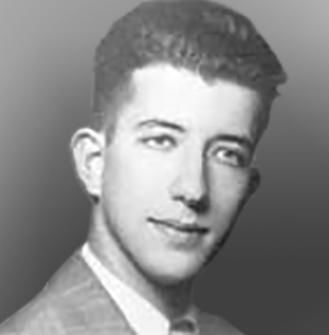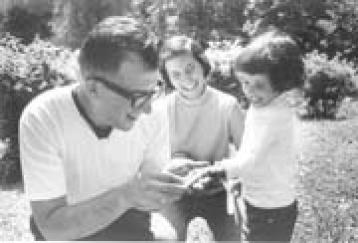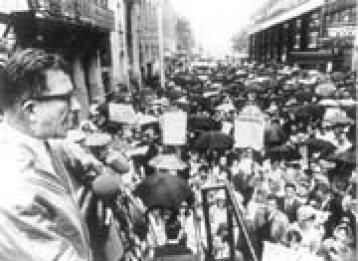Brief Chronology of the Life of Albert Shanker

Albert Shanker as a teen.
Sept. 14, 1928 Born to immigrants from Czarist Russia: his father Morris, who delivered newspapers, and his mother Mamie, a garment worker holding union cards in both the International Ladies Garment Workers Union and Amalgamated Clothing Workers Union.
1946 Graduated from Stuyvesant HS, where he headed the debate team. Enrolled in the University of Illinois at Champaign-Urbana. In college joined the recently formed Congress of Racial Equality.
1949 Graduated with honors with degree in philosophy. He enrolled in doctoral program in philosophy at Columbia University, intending to become a college professor. He would complete all coursework but not his thesis. Married Pearl Sabbath; they would have son, Carl.
1952 To earn money to complete dissertation, he took a teaching job as a per diem substitute at PS 179 in East Harlem.
1953 Moved into a regular sub position at JHS 126 in Queens. He met other young radical teachers George Altomare (later a UFT vice president) and Dan Sanders (later a NYSUT officer) and organized his school for the Teachers Guild.
1959 Left job teaching at JHS 88 in Manhattan to become a full-time Teachers Guild organizer.
1960 The Teachers Guild merges with the breakaway faction of High School Teachers Association to form UFT. Soon after, the UFT strikes for one day to demand collective bargaining rights.
1961 NYC teachers choose the UFT as the collective bargaining agent, the first time in the United States that teachers would have the right to negotiate for better wages and working conditions. After his first marriage ended in divorce, he married Edith (Eadie) Gerber. They would have three children, Adam, Jennie and Michael.
1962 Shanker was elected UFT secretary.
1964 He succeeds Charles Cogen as UFT president.
1967 Leads three-week strike for smaller classes and more money for education. He goes to jail for 15 days for violating the state law prohibiting strikes by public employees.
1968 Leads long and bruising Ocean Hill-Brownsville strike over due process rights for members.
1969 Goes to jail for another 15 days for his role in 1968 strike. Shanker brings paraprofessionals into the UFT.
Dec. 19, 1970 Begins "Where We Stand" column in the New York Times.
1972 As head of the American Federation of Teachers' statewide organization, Shanker worked with Tom Hobart, the Buffalo teacher who led the National Education Association's statewide affiliate, to form NYSUT. After serving as co-president with Hobart, Shanker became NYSUT executive VP until 1978.
1973 Elected VP and executive council member of AFL-CIO. He would head the national federation's international affairs committee. Woody Allen spoofs him in “Sleeper.” He joins the International Rescue Committee.
1974 Elected AFT president. Shanker would be re-elected every two years thereafter.
1975 In financial chaos, NYC dismisses some 15,000 teachers. As the DOE-UFT contract expires, teachers return to school in September to find over 50 children in a class. The UFT Delegate Assembly recommends a strike and 23,000 at Madison Square Garden roar approval. The strike lasts five days, and members win longevity increases for 10 and 15 years of service. Shanker later plays a key role in saving NYC from bankruptcy by asking the Teachers' Retirement System to invest $150 million in Municipal Assistance Corp. bonds.
1976 Elected delegate to Democratic National Convention this year and again in 1980, 1984, 1988, and 1996.
1983 Joins the Committee on Economic Development's education task force. Shanker embraces the Reagan administration's "A Nation at Risk" report, which condemned the state of American education and called for higher standards.
1985 Serves on the Carnegie Forum on Education and the Economy task force on teaching as a profession. He first floats the idea of a rigorous national teachers exam in a speech at the National Press Club. He resigns UFT presidency and is succeeded by Sandra Feldman in January 1986.
1986 Shanker becomes a visiting professor at Hunter College/CUNY.
1987 Shanker is a visiting professor at Harvard this year and also in 1988, 1989 and 1990.
1988 Shanker testifies for funding needed to start the work of the National Board for Professional Teaching Standards, which grew out of his 1985 speech.
1989 President George Bush names him to the President's Education Policy Advisory Group.
1993 Shanker is the founding president of Education International, the union formed by merger of AFT/NEA international affiliates.
1996 Shanker announces the AFT's "Lessons for Life" campaign, which calls for higher standards of student conduct and achievement. He is named a fellow of the American Academy of Arts and Sciences, the only labor leader to sit beside Nobel laureates and Pulitzer Prize winners.
Feb. 22, 1997 Shanker dies at age 68.
Memberships
AFL-CIO Executive Council; Jewish Labor Committee; A. Philip Randolph Institute; Spence Foundation; U.S. Council on Competitiveness; Joint Council on Economic Education; Freedom House, National Endowment for Democracy; International Rescue Committee; Trilateral Commission; Committee for Economic Development.
Awards
Creative Leadership Award, NYU School of Education, 1978; Heritage of Liberty Award, Anti-Defamation League of B'nai B'rith, 1978; Distinguished Service Award, SUNY Albany School of Education, 1984, and Graduate School of Education and Human Development, University of Rochester, 1986; James E. Allen Memorial Award, SUNY 1986; Labor Management Award, Work in America Institute, 1990; Distinguished Service Medal, Columbia University Teachers College, 1990.

